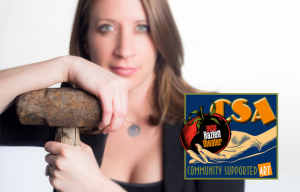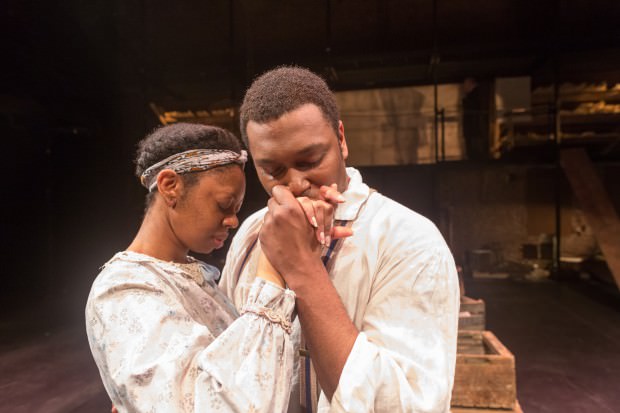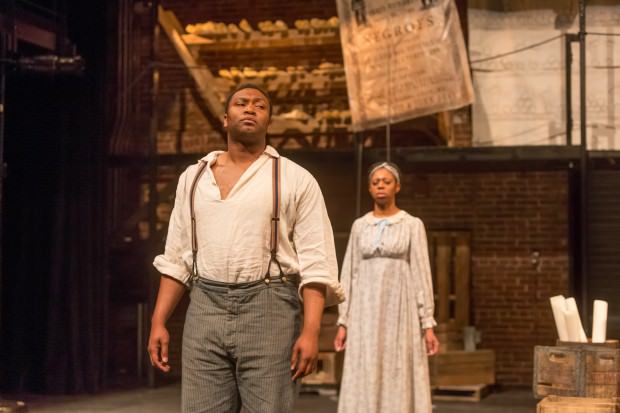JH: Mechanics of a Legend Review

By Wendy Arons, The Pittsburgh Tattler
On April 2 the CSA audience was treated to the rare opportunity to give feedback on a new work-in-progress. JH: Mechanics of a Legend is a new play by Anya Martin (artistic director of Hiawatha Project) that has been in development since 2012. Because Hiawatha Project is committed to making work that speaks to social issues within the community, Martin has adopted a multi-phase creation cycle that loops stakeholders and audiences in to the development process. The April 2 workshop presentation represented the middle, crucial stage in a creative process that began two years ago with identification of a social question and its story (in this case, the legend of John Henry and its connection to institutionalized racism), moved through an intensive phase of research and investigation of source materials, and then, in the last several months, brought the inventiveness and inspiration of a number of artistic and community collaborators into conversation and physical exploration to devise and create the work. The workshop production was something like a “beta release” of software, offered to the public in the spirit of learning how the piece functions and resonates with an audience. Feedback gathered from the post-show discussion and from comment slips filled out by audience members will then help Martin and her creative team revise and reshape the work in the coming months, with the aim of fully producing a final version some time next year.
Given these circumstances, it would be neither fair nor useful for me to write a traditional “review” of the play, especially since, as a member of both the creative team and Hiawatha Project’s board, I do not have the necessary critical distance to review the play even if it had been presented as a finished product. So in lieu of a review, I offer here some reflections on how the work came to take its present form and on the audience responses shared in the post-show discussion.
JH: Mechanics of a Legend steps back from the well-known ballad of John Henry to ask: what social and political issues are being addressed in that legend’s figuration of a battle of man against machine? In seeking the language and ideas to answer that question, Martin harvested text and insight from two very different fields. On one hand, inspired by Scott Reynolds Nelson’s historical investigation of the “real” John Henry in his book Steel Drivin’ Man, Martin unearthed primary source documentation from the reconstruction period (slave diaries, news articles, historical speeches) as well as secondary historical accounts of slavery and reconstruction to contextualize who “John Henry” stands for in the ballad and to understand the social and institutional forces encoded in the song. The historical John Henry, according to Nelson, was likely a free black man who had fallen victim to the newly enacted “Black Codes” in the post-Civil War South, codes that essentially reinstituted de facto slavery by allowing judges to sentence criminals convicted of minor crimes to chain gang labor on the railroads. On the other hand, in pursuit of language that would allow her to talk about the “machine” John Henry dies fighting, Martin looked to physics, mechanics, and engineering for explanations of how machines work. Grade school physics textbooks provided definitions of simple and complex machines and the physical laws governing them that resonated beyond engineering and spoke – often quite poetically – to the socio-political-economic machinery that extracted profit from enslaved black labor, both before and after the Civil War.
The found text from these two sets of investigation was then interwoven into what Martin likes to describe as a “long form poem” that traces how the “machine” of slavery, having been broken down by the Civil War, had its constituent “parts” repurposed into new social and legal institutions that effectively continued slavery by another name. Together with set designer Britton Mauk, Martin found visual symbols for the practices and forces of slavery that were taken up again to continue to oppress African-Americans after slavery was abolished. For example, in the play the whip – a symbol of the violence and torture used by white slaveowners to discipline black slaves – becomes the noose of the lynch mobs that terrorized free black men in the post-Civil War era. The play’s conceptual scaffold – realized mainly through scenery and movement – was built upon the circulation of these symbols. Components of the machinery of slavery, having been dispersed by the war, became the mountain John Henry was tasked with breaking down. As the Engineer (Kyle Bostian) – symbol of capitalism and of the “mechanical advantage” conferred on whites by their exploitation of black labor – discovered the need for each component for the new “machine” he was inventing, the Mechanic (Tom Driscoll) – the white working class man caught in the middle – scoured the rubble for the necessary remnants of the slave driving system and coerced John Henry (Monteze Freeland) to exert labor to heave them back up to the Engineer for reuse in his new machine. The steam drill of the legend, then, here represents a new machine for the exploitation and oppression of African-Americans, extracted – as was the original wealth of the nation – from their compelled and unpaid labor. John Henry’s desire to defeat the steam drill becomes, in such a context, a metaphor for an act of political defiance. Threaded through this story of the social, political, and economic mechanisms that cemented white power over African-Americans is the ballad’s love story between John Henry and his wife, Polly Ann (Delana Flowers) – a story that not only gives human dimension to the play but also reminds us of the ways in which slavery and reconstruction had lasting aftereffects on African-American families, through forced separations of husbands and wives and through sexual abuse and exploitation of black women by white men.
It was clear from audience feedback that the play’s intertwining of the language of mechanics with the legend of John Henry helped open a window into the history of African-American experience; audience members were moved, disturbed, and provoked by the history revealed in the found texts and understood the metaphorical connections between the machine of the legend and the “machinery” of oppression. Comments made by audience members during the hour long post-show discussion ranged from observations about the play’s structure to the ways in which John Henry’s experience at the hands of a racist and rigged justice system continues to resonate: one spectator observed that the play was a “scary realization of the chains we still wear today.” For the creative team, the fact that those parallels surfaced for audience members was particularly gratifying, since many of the initial developmental conversations centered on this history’s relevance to the current conversation about institutionalized violence against African American men. John Henry’s victory against the steam drill was, sadly, a tragic one: dying with his hammer in his hand, John Henry joins a long history of African-American men who sacrificed their lives in an attempt to assert their humanity in the face of white power.


